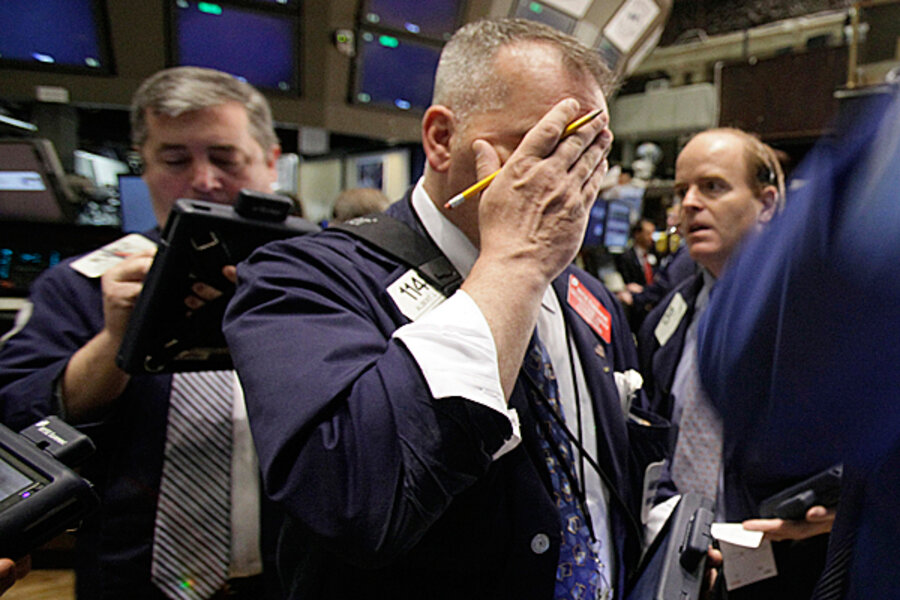Financial reform: Will the next crisis be handled differently?
Loading...
Fast-forward to the next time a Lehman Brothers or an AIG is on the brink of failure. Will financial reform mean that Washington responds in a different way and that the economy is better protected?
That question goes to the heart of the financial reform debate that is now entering an endgame in Congress.
The response will be different, it appears, because both the Senate and House bills would give policymakers new tools – notably the ability to seize a large nonbank firm like AIG and dismantle it.
"There will be no more taxpayer-funded bailouts, period," President Obama said Friday after a meeting with key lawmakers. Despite that pledge, however, the new law also enables the government to provide massive federal support for the banking system during a new crisis, on a similar scale to what occurred in 2008.
And although Mr. Obama said the reform is needed "so that a crisis like this does not happen again," nothing guarantees that it will succeed. Some finance experts are optimistic that the measure will reduce the risk, but others are not.
To understand how things may change, first recall some challenges that policymakers faced in 2008.
How the old system failed
The depths of the crisis were reached after Lehman Brothers went bankrupt. Credit channels froze amid uncertainty about how bad the ripple effects would be. AIG, on the other hand, was controversially rescued days later.
A key problem was that officials had no authority to seize control of a large failing firm that wasn't a traditional bank, say both then-Treasury Secretary Henry Paulson and current Treasury Secretary Timothy Geithner. In other words, there was no middle option between bailout and bankruptcy.
The tools at hand resulted in market uncertainty, big taxpayer costs, and ad hoc policymaking (including the rush by Congress to create the $700 billion Troubled Asset Relief Program, or TARP).
Compared with that, the new setup would be a big step forward, many finance experts say. Regulators would have new powers to try to prevent a crisis and new "resolution authority" to handle complex firms that collapse.
Here's a look at the pros and cons in the debate over whether financial reform will succeed.
Three lines of defense
Under the new plan, there are three lines of defense. The first line, to prevent a crisis, is supposed to be the discipline of financial markets themselves. The reform seeks to revive marketplace discipline on several fronts.
The Senate bill, for example, requires that firms hold onto at least a 5 percent stake in any loan-pool securities that they sell to others. It also seeks to make the credit-rating business more competitive to serve the interests of investors, rather than the issuers of securities. Also, the Federal Reserve would have some oversight of the pay incentives at financial firms.
A second line of defense is the regulators. Reform would create a financial oversight council led by the Treasury secretary. This panel would have a new and broad mission: to track financial risks throughout the economy, not just within a single sector such as banks or insurance firms. A key goal is to have tough capital standards, so that prominent firms operate with a safe cushion against potential losses.
A third line of defense is the tools to deal with a crisis, if it occurs. The reform provides that failing firms can be taken over and that shareholders and creditors can be exposed to possible losses as pieces of the firm are sold, shut down, or restructured. If the process requires outside money, the financial industry would be billed, not taxpayers.
Will it work?
If these are steps forward, what's the potential problem with all this? The problem, critics say, is summed up in the phrase "moral hazard."
If key industry players believe they will be bailed out in a crisis, they have less incentive to be vigilant in controlling the risks they take. This so-called moral hazard affects a variety of players, including bankers as well as investors who provide liquidity to banks.
Yes, financial reform calls for an end to taxpayer bailouts of specific firms. But it continues to allow the government to provide broad support to the financial industry during a crisis.
If the whole economy is at risk, creditors of a failing bank could be largely spared losses because of federal guarantees. Many economists say it's good that the reforms provide this flexibility. In 2008 and 2009, such actions prevented a systemwide collapse, they say.
The prospect of creditor backstops from the government just isn't much help in reducing moral hazard.
"Counterparty risk is a big thing," says Peter Nigro, an economist at Bryant University in Smithfield, R.I. "That was wrong," he says, when the government enabled AIG to pay its derivatives contracts in full, so that creditors including Goldman Sachs got 100 cents on the dollar.
The reforms would also formally identify certain firms as systemically important – which could make them feel "too big to fail." In fact, the biggest banks have grown larger in the past two years – in effect even more important – because of crisis-related consolidation in the industry.
Then there's the "watch what we do, not what we say" factor. The way Washington responded in 2008 probably speaks louder to Wall Street than any no-more-bailout speeches by politicians.
The big question is how the reforms will be implemented. The House and Senate bills leave much to the discretion of top regulators. They're being asked to set the policies and the general tone for American finance.
Related:





